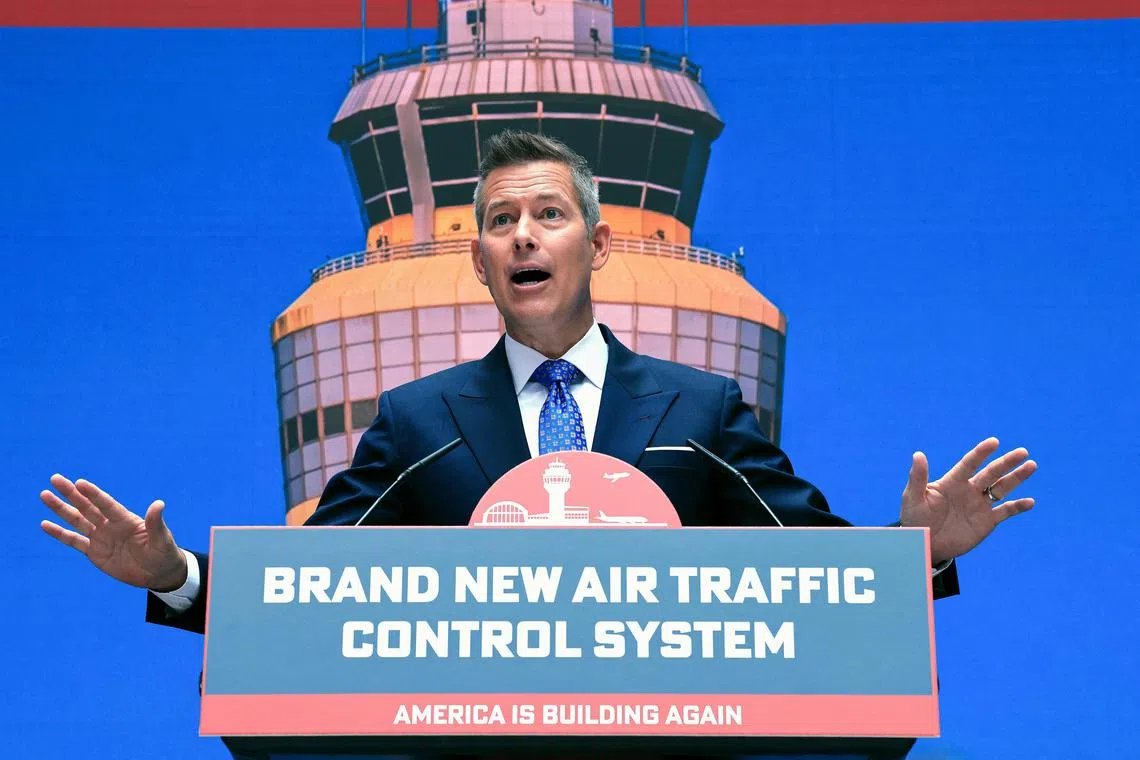US unveils ambitious air traffic control upgrade
Sign up now: Get ST's newsletters delivered to your inbox

Transportation Secretary Sean Duffy said he would push Congress to provide “all of the money up front” to ensure the project meets an ambitious three to four year timeframe.
PHOTO: AFP
Follow topic:
NEW YORK - The Trump administration unveiled a plan on May 8 to overhaul the antiquated US air traffic control system, acting with industry and lawmakers’ support on a hot-button issue after a deadly crash in January.
Transportation Secretary Sean Duffy described the initiative as a once-in-a-generation upgrade – a project involving the rebuilding of some air traffic control towers and the replacement of radar, sensors and telecommunications with completely state-of-the-art versions.
“I don’t need to preserve any of this,” Mr Duffy said, pointing to a table with 1980s computers, floppy disks and other outmoded equipment still in use at US air traffic facilities.
“We’re going to build a brand-new car,” he added. “It’s a brand-new system.”
Speaking to those at the event on speakerphone, US President Donald Trump pledged the overhaul “will bring American air traffic control into the highest level of anybody, any country anywhere in the world”.
Such a transformation could require tens of billions of dollars that would need congressional support at a time when Mr Trump’s administration is also seeking deep, across-the-board spending cuts to finance tax cuts.
Mr Duffy did not release an overall price tag during the 75-minute launch event that often resembled a pep rally.
Funding for air traffic infrastructure has averaged US$3 billion (S$3.9 billion) per year for the past 15 years, according to a Transportation Department handout, which called for “an immediate infusion of funding to address critical infrastructure needs”.
Mr Duffy said he would push Congress to provide “all of the money up front” to ensure the project meets an ambitious three- to four-year timeframe.
The House transportation committee last week approved a preliminary plan for US$12.5 billion as a step towards air traffic control modernisation, but that proposal is still winding its way through Congress.
The Modern Skies Coalition, which represents more than 50 aviation stakeholders, estimated that at least US$18.5 billion in additional emergency spending was needed over the next year, bringing the total to more than US$31 billion.
“The staffing and technology challenges facing the National Airspace System did not appear overnight,” the coalition said.
Newark in focus
At the launch event, Mr Duffy and other speakers acknowledged people who lost relatives in the fatal January collision between a regional passenger jet and a military Black Hawk helicopter
The effort also comes on the heels of an April 28 incident at Newark Liberty International Airport in which air traffic officials stationed in nearby Philadelphia lost radar and radio contact with planes for 90 seconds.
The Federal Aviation Administration has been reducing arrivals and departures at Newark following the incident, which traumatised some air traffic control staff and caused delays and flight cancellations.
Mr Duffy said the Newark incident underscored the need for action, warning that without a fix, “you’ll see new Newarks in other parts of the country because it’s an ageing system”.
Speakers at the event included National Transportation Safety Board chair Jennifer Homendy, who said the watchdog body has seen recommendations for system upgrades going back almost 30 years get ignored.
“This is bold, but I have to tell you it is absolutely necessary to ensure safety in our skies,” Ms Homendy said.
Mr Nick Calio, president of Airlines for America, which represents US passenger and cargo airlines, said this is “a once-in-a-lifetime opportunity”.
“It’s to finally get something done to stop the deterioration of our airspace,” he said.
In the build-up to the May 8 announcement, Mr Duffy had taken frequent shots at his predecessor, Mr Pete Buttigieg, blaming the Biden administration transportation secretary for the problems at Newark and elsewhere in the system.
But Mr Duffy, a former reality television star who served in the House of Representatives for nine years, adopted more of a big tent approach to May 8’s event, welcoming Democratic Representative Rick Larsen, a senior lawmaker on transportation, who echoed the need for action.
“We’ve talked about how this effort sometimes spans administrations,” Mr Larsen said. “We don’t want the effort to span generations.” AFP

